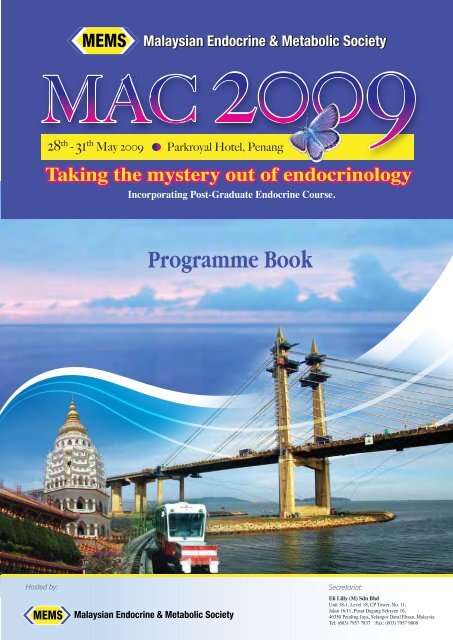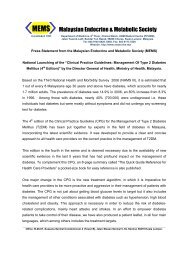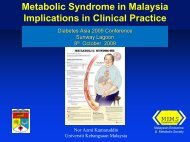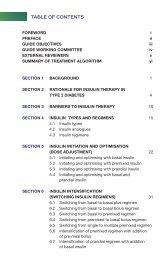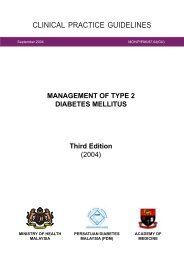MAC 2009 â programme book (English - pdf - 3082 Kb) - MEMS
MAC 2009 â programme book (English - pdf - 3082 Kb) - MEMS
MAC 2009 â programme book (English - pdf - 3082 Kb) - MEMS
- No tags were found...
Create successful ePaper yourself
Turn your PDF publications into a flip-book with our unique Google optimized e-Paper software.
Parkroyal Hotel, PenangProgramme Book
Taking the mystery out of endocrinologyMalaysian Endocrine & Metabolic Society Annual CongressContentsWelcome Message from PresidentOrganising Committee andWelcome Message from Organising ChairmanCouncil Members ofMalaysia Endocrine & Metabolic Society (<strong>MEMS</strong>)Invited FacultyVenue Layout PlanExhibition Floor PlanExhibitorsMapConference InformationPre-Congress WorkshopScientific ProgrammeAbstractsAcknowledgement2456789101112141728
Taking the mystery out of endocrinologyMalaysian Endocrine & Metabolic Society Annual CongressMessage from the President of <strong>MEMS</strong> 2008-<strong>2009</strong>Dear Friends and Colleagues,On behalf of the Malaysian Endocrine & Metabolic Society (<strong>MEMS</strong>), I would like to take thisopportunity to welcome everyone to this inaugural Annual Congress of the Society. This year wehave combined the Congress with the postgraduate endocrine course with the sole objective of incorporatingthe basic science strand, oral and poster presentations together with the plenary lectures and clinical casepresentations which had been regular features in our previous postgraduate endocrine courses. We hope thiseffort will expand the scope of the meeting and thus provide a venue for basic and clinical science research inendocrinology to prosper in this country.Vision & Mission of <strong>MEMS</strong>.In our last council meeting, a blueprint was outlined for the society to pursue in the next five years. Taking intoaccount the reality of endocrinology in this country, we believe that this will serve as the vision and mission ofthe society in the years to come.Vision of the SocietyIt is our vision that <strong>MEMS</strong>a. will be the voice of endocrinology & metabolism in this country and serve as the point of reference inissues pertaining to endocrinology and metabolism to help shape policy that encompasses these areas.b. will pave the way for coordination and collaboration of endocrine expertise, training and services in thecountryc. be the impetus and stimulus for advancement in research and patient-care in endocrinologyd. will inculcate in its members the importance of professional independence and integrityMission Statement1. It is our objective to turn the society into the voice of endocrinology and metabolism in this country thatgovernment, non-governmental organizations and the community will refer to by providing leadership andestablishing the Society as an esteemed professional body.2. The Society will coordinate various endocrine expertise and services in the country. Effort will be expendedto consolidate and strengthen those which are established and initiatives will be undertaken to start newservices in other centers.3. The Society will actively involve itself in the training and credentialing of endocrinologists in the country.4. The Society continues to serve as a body that will generate research and expertise in the various fields ofendocrinology.5. The Society will endeavour at every opportunity to instill professional integrity and independence in itsmembers, cognizant that patronage by pharmaceutical companies may inadvertently subject its members topartiality in his or her dealings.6. The Society will provide the platform for basic science in endocrinology to flourish by promoting life sciencestopics in our major <strong>programme</strong>s and workshops.7. The Society will also devote resources into developing certain areas in endocrinology in this country that arefragmented including those that are neglected such the orphan diseases.2
Plan of action1. The Society will work with relevant governmental and non-governmental institutions and bodies in the fields ofendocrinology and metabolism, taking a leadership role where appropriate.2. The Society will act as a consultative body and interest group in the formulation of policies at various levelspertaining to endocrine and metabolic diseases.3. The Society through its executive council, will issue media statements periodically pertaining specifically toendocrinology and metabolism matters of public concern.4. The Society shall be jointly responsible together with the Ministry of Health and Academy of Medicine for thecoordination, implementation and assessment of advanced training in endocrinology.5. Meetings to address availability of resources in endocrinology and how best to develop them will be held, soas to reduce unnecessary duplication especially in time of economic hardship. Main areas of expertise inendocrinology will be identified and nurtured.6. The Society will make a formal approach to relevant professional bodies and authorities to address certainpertinent issues including addressing the lack of dedicated pituitary surgeons, consolidation of current invasiveradiological procedures and the setting up of diagnostic molecular laboratory services in the country.7. The Society will initiate the formation of databases for selected endocrine diseases. In addition to monitoringthe management of these diseases we will aim to implement changes that will improve the outcome.8. The Society will engage itself in areas of research of national interest, primarily in the topic of iodinisationlevels in pregnancy as one of its main research thrusts. The escalation of obesity and diabetes in this countryand the possible causal role of the Malaysian dietary composition is another subject of concern. Similarly inthis context the Society will initiate a CPG for gestational DM with emphasis on post-natal health of themothers.9. Embracing the spirit of accountability and transparency, the society now requires all speakers speaking on itsplatform to publicly disclose any potential conflict of interest at the beginning of their presentations. This willhelp our audience to judge the impartiality of any scientific presentations.10. Public awareness programs will be organized to highlight the plight of diseases such as thyroid, adrenal,pituitary etc. Some of these <strong>programme</strong>s will be in collaboration with other professional societies.Over the past one year, the Society has successfully acquired a meeting place, organised a postgraduate course inKota Kinabalu, revised two CPGs (DM2 & Growth Hormone), started an education trust fund, initiated travelgrants for adult, paediatric and life sciences members to attend and present their work at international meetings,continued to award small research grants and employ the services of an IT company to launch our webpage.Monthly adult and paediatric clinical meetings continued to be a valuable source of CME for the trainees andtrainers alike.Allow me to also take this opportunity to thank Assoc. Prof. Dr. Malik Mumtaz and his OrganisingCommittee for their unrelenting zeal in ensuring the success of this Congress. Of course, this Congresswould not be possible without the enthusiastic participation of speakers and delegates alike. Lastly, thecontribution of the various pharmaceutical in providing secretariat support, sponsoring the symposia,exhibition booths and bringing in speakers and participants will ensure that these kinds of <strong>programme</strong>swill continue to benefit the medical and scientific community for many more years to come.We do hope everybody has an enjoyable and beneficial time during the Congress..............................................Prof. Dr. Nor Azmi KamaruddinPresident of Malaysian Endocrine & Metabolic Society3
Taking the mystery out of endocrinologyMalaysian Endocrine & Metabolic Society Annual CongressMessage from Organising ChairmanDear colleagues,On behalf of the Malaysian Endocrine And Metabolic Society (<strong>MEMS</strong>) and thePenang organizing committee, I would like to warmly welcome you to the 1st<strong>MEMS</strong> Annual Congress <strong>2009</strong> (<strong>MAC</strong> <strong>2009</strong>) here in beautiful Batu Ferringhi.The Congress will span 3 days and starts with pre-congress workshop on insulin pump therapy,imaging in endocrinology and a workshop for nurses. The main congress will focus on importantaspects of endocrinology. Various local experts and oversea guests will deliver these topics.The format is primarily case-based and interactive. It is our great privilege to work closely with ourcolleagues from the life sciences with their participation, it is hoped that the meeting will cover allaspects of endocrinology, from basics to clinical management.We hope that you will enjoy your time in Penang and make full use of the academic sessions as wellas leave time to enjoy the delights of this beautiful location.Finally, I would like to thank the <strong>MEMS</strong> committee, members of the local organizing committee andall our friends from the pharma industry who have generously lent their support. A special mentionto Eli Lilly for graciously agreeing to bear the headache of being the secretariat for this congress.Thank you,.............................................Dr. Malik MumtazOrganising Chairman, <strong>MAC</strong> <strong>2009</strong>Organizing Committee:ChairmanMembers: Dr. Malik Mumtaz: Prof. Dr. Amir KhirDr. Yeow Toh PengDr. Khaw Chong HuiDr. Shanty VelaDr. Ang Hock AunDr. Nor AzizahDato' Dr. L R ChandranDr. Haniffulah Khan4
Taking the mystery out of endocrinologyMalaysian Endocrine & Metabolic Society Annual CongressCouncil Members ofMalaysia Endocrine & Metabolic Society (<strong>MEMS</strong>)PresidentVice PresidentProf. Dr. Nor AzmiKamaruddinDr. Malik MumtazHonorary Treasurer Honorary Secretary Asst. Honorary Secretary Council Member Council MemberDr. Wan NazaimoonWan MohamudDr. Zanariah HusseinDr. BadrulnizamLong BidinDato' Dr.LR ChandranDr. Letchuman GRCouncil MemberCouncil MemberCouncil MemberCouncil MemberCouncil MemberDr. Hanifullah KhanDr. MohdArifin Mohd AliDr. Hew Fen LeeDr. Fuziah Md ZainProf. Dato' Dr.Wan MohamadWan Bebakar5
Taking the mystery out of endocrinologyMalaysian Endocrine & Metabolic Society Annual CongressInvited FacultySeberang Jaya HospitalMalaysiaMalaysiaKlinik Kesihatan Simpang KualaResearch Instruments Sdn BhdPenang Medical College6
SERVICEAREAFIRST FLOORPASSAGEWhite Board/ScreenWhite Board/ScreenWhite Board/Screen7M (23FT) 7.8M (26FT)7.8M (26FT)PALALAWANGJINTANCORRIDORCollapsible PartitionsJINTAN ITIFFINSRESTAURANTVenue Layout PlanGROUND FLOORCollapsible Partitions23M (76FT)12M (39.5FT)Staircase ToiletToiletWindowSERAIWhiteBoard/ScreenPRE-COCKTAILAREA8M (26.9FT)FOYERWhiteBoard/ScreenLiftWhiteBoard/ScreenHospitalityRoom /BridalShowroom5.9M(19FT)WindowBALLROOM IScreenANDAMANGRANDBALLROOMBALLROOM II7.8M (26FT) 15.3M (50FT)To Tamarind BrasserieEntranceTo Main Lobby8M (26.9FT)20M (65FT)WindowLADAExternalEntranceWindow14.4M (47FT)HALIABalconyBalconyBalconyBalconyBalconyWindowBusiness CentreScreenPre-Cocktail &Foyer - 21 tables (2.5ft x 6ft)StraircaseWindow10M (33FT)Window16M (53FT)StraircaseLiftCORRIDORPANDANWhite Board/Screen7.8M (26FT)ToiletScreen20M (66FT)7
Taking the mystery out of endocrinologyMalaysian Endocrine & Metabolic Society Annual CongressExhibition Floor Plan (Ground Floor)GROUND FLOORSTAGEReception1820 21 12191716Total 21 table(2.5 feet x 6 feet)1413153 412 11 10 9 8 7568*The Organiser reserves the right to make last minute adjustment
Exhibition Floor Plan (First Floor)StraircaseLADASERAI222324BoothCompanyExhibitorsBoothCompany1Eli Lilly (M) Sdn Bhd13Abbott Laboratories (M) Sdn Bhd23Roche Diagnostic (M) Sdn BhdMerck Serono1415Abbott Laboratories (M) Sdn BhdiNova Pharmaceuticals4Novo Nordisk Pharma (M) Sdn Bhd16Novartis Corp (M) Sdn Bhd5Pharmalink-Takeda17Novartis Corp (M) Sdn Bhd6Genzyme18GlaxoSmithKline Pharmaceuticals Sdn Bhd7AstraZaneca Sdn Bhd19GlaxoSmithKline Pharmaceuticals Sdn Bhd8AstraZaneca Sdn Bhd20Servier (M) Sdn Bhd9Sanofi Aventis (M) Sdn Bhd21Eli Lilly (M) Sdn Bhd10Sanofi Aventis (M) Sdn Bhd22Solvay Pharma11Merck Sharp & Dohme Corp.23Info Resources Services12Merck Sharp & Dohme Corp.24St Nicholas Home9*The Organiser reserves the right to make adjustments if deemed necessary
Taking the mystery out of endocrinologyMalaysian Endocrine & Metabolic Society Annual CongressMap (Penang)10
Taking the mystery out of endocrinologyMalaysian Endocrine & Metabolic Society Annual CongressConference InformationRegistration CounterGround Floor, Park Royal Hotel, Penang.Operation Hours28th May <strong>2009</strong>29th May <strong>2009</strong>30th May <strong>2009</strong>31th May <strong>2009</strong>0700 - 1700 hr0700 - 1700 hr0700 - 1700 hr0700 - 1200 hrOpening Ceremony andWelcome ReceptionClosing CeremonyThursday, 28th May <strong>2009</strong>, 1700 hr, Grand Ballroom, Ground Floor,Park Royal Hotel, Penang.Sunday, 31th May <strong>2009</strong>, 1200 hr, Grand Ballroom, Ground Floor,Park Royal Hotel, Penang.Oral Presentation• Please be prepared at your allocated venue at least 10 minutes prior tothe start of the session.• Please remember that the time allotted to oral session is 8 minutes forpresentation and 2 minutes for questions and answers.Posters Presentation Mounting : 0800 - 0900 hr, 29th May <strong>2009</strong>Dismantling : 1100 - 1130 hr, 31th May <strong>2009</strong>• The Organiser bears no responsibility for any loss ordamage to posters.11
Taking the mystery out of endocrinologyMalaysian Endocrine & Metabolic Society Annual CongressPre-Congress WorkshopImaging For The Endocrinologist28th May <strong>2009</strong> (Thursday)Grand Ballroom, Ground Floor14:00 - 14:1014:10 - 14:5014:50 - 15:3015:30 - 16:0016:00 - 16:4016:40 - 17:0017:00: Introduction & Overview: Ultrasonography in Endocrine Diseases Dr. Chong Fook Looi: CT Scan & MRI in Endocrinology Dr. Dennis Tan: Tea Break: PET Scanning in Endocrinology Dato Dr Ali Kadir: Q&A: End of WorkshopPractical Aspect of InsulinPump Therapy Workshop28th May <strong>2009</strong> (Thursday)Pandan Room, First Floor13:00 - 14:0014:15 - 15:0015:00 - 15:1515:15 - 16:1516:15 - 17:0017:00 - 17:10: Registration: Overview of Insulin Pump Therapy Prof. Chan Siew Pheng: Coffee Break: Pump ProgrammingMedtronicWhat You Need to Know About Disposables Medtronic: Hands on Break Out Medtronic: Closing Remark12 *The Organiser reserves the right to make last minute adjustment
Pre-Congress WorkshopDiabetes Conversation Map TM28th May <strong>2009</strong> (Thursday)Jintan Room, First Floor14:00 - 14:3014:30 - 16:3016:30: Welcome Refresshments & Registration: Diabetes Conversation Map TM Implementation WorkshopDr. Arlene Ngan: Tea Break & ClosingOpening Reception Cocktail AndWelcoming Ceremony28th May <strong>2009</strong> (Thursday)Grand Ballroom, Ground Floor17:00 - 17:45 : Registration and Cocktail17:45 - 18:00 : Opening AddressDr. Malik Mumtaz (Organising Chaiman)Prof. Dr. Nor Azmi Kamaruddin (<strong>MEMS</strong> President)18:00 - 19:0019:00 - 19:30: OpeningThe Last 30 Years In Endocrinology: A JourneyProf. Dato’ Dr. Khalid KadirThe Last 30 Years In Diabetes: A JourneyProf. Dato’ Anuar Zaini: 1) Launching of <strong>MEMS</strong> Website2) Official Opening of <strong>MAC</strong> <strong>2009</strong>Prof. Dr. Nor Azmi Kamaruddin13*The Organiser reserves the right to make last minute adjustment
Taking the mystery out of endocrinologyMalaysian Endocrine & Metabolic Society Annual CongressScientific Programme29th May <strong>2009</strong> (Friday)Time07:00 - 09:0009:00 - 09:4009:40 - 10:2010:20 - 10:5010:50 - 11:25Novo Nordisk Breakfast Symposium (Grand Ballroom)Ideal Start & Easy Intensification with NovoMix30 Prof. Dato' Wan Mohamad Wan Bebakar Chairman: Dr. Mohamed BadrulnizamGrowth Hormone Use in Adults Dr. Hew Fen Lee Chairman: Dr. Mohamed BadrulnizamPlenary : “ Highlights of the <strong>2009</strong> Clinical Practice Guidelines in T2DM” (Grand Ballroom)Prof. Wan Mohamad Chairman: Dr. Zanariah HusseinPlenary : HsCRP, BNP, PAI etc; What To Make Of All These Emerging Inflammatory Markers? (Grand Ballroom)Dr. Hamat Hamdi Chairman: Prof. Dr. Nor Azmi KamaruddinCoffee BreakPlenary : HbA1c: How Low Should We Go? (Grand Ballroom)Prof. Dato' Dr. Mafauzy Mohamed Chairman: Prof. Amir S Khir11:25 - 12:0512:05 - 12:45Adult TrackBreak Out SessionPaediatric Track12:45- 14:00 MSD Lunch Symposium (Grand Ballroom)Achieving Glycemic Control Without Compromise: The Role of DPP-4 InhibitorsBreak Out Session14:00- 14:4014:40- 15:3015:30- 16:0016:00- 17:00A 65 Years Old Man WithProgressive Loss OfHeight And Back Pain(Grand Ballroom)Dr. Vijay / Dr. Hew Fen LeeA 65 Years Old Man WithProgressive Loss OfHeight And Back Pain(Jintan Room)Dr. Vijay / Dr. Hew Fen LeeLife Science:MolecularTechnology SymposiumMy Calcium Level Is High. Bone Health And Hormonal Aspects Application Of Microarray:Should I Be Worried? Of Children With Chronic Diseases From Lab To Clinical Practice(Jintan Room) (Halia Room) (Serai Room)Dr. Wong Ming /Dr. Janet HongDr. Thomas J MurphyProf. Dr. Chan Siew PhengMy Calcium Level Is High.Should I Be Worried?What Do Paediatricians Need To KnowAbout Rickets?RNA: From Lab Tool ToTherapy(Grand Ballroom) (Halia Room)(Serai Room)Dr. Wong Ming /Prof. Fatimah HarunDr. Thomas J MurphyProf. Dr. Chan Siew PhengAdult TrackThe Radiologist Found A Mass In My Patient’s Adrenal Gland,What Should I Do? (Grand Ballroom)Dr. Florence Tan / Prof. Dato' Dr. Mafauzy MohamedThe Radiologist Found A Mass In My Patient’s Adrenal Gland,What Should I Do? (Jintan Room)Dr. Florence Tan / Prof. Dato' Dr. Mafauzy MohamedCoffee BreakFree Paper Presentation (Grand Ballroom)Neuroendocrine Syposium Chairman: Dr. Hew Fen LeeProf. Chan Siew PhengMy Patient Has Hpertension & Low Potassium(Jintan Room)Prof. Dr. Nor Azmi Kamaruddin / Dr. Ang Hock AunMy Patient Has Hypertension & Low Potassium(Grand Ballroom)Prof. Dr. Nor Azmi Kamaruddin / Dr. Ang Hock Aun17:00- 17:3017:30- 18:001. Acromegaly : Somatostatin Analogue Treatment On A Shoe String Budget. (Grand Ballroom) Dr. Zanariah Hussein2. Radio Surgery For Pituitary Tumors. (Grand Ballroom) AP Biswa Mohan Biswa19:00- 21:00 Lilly Dinner Symposium (Grand Ballroom)The Treatment Continuum of Osteoporosis Prof. Chan Siew PhengCase Presentation Dr. Malik Mumtaz14*The Organiser reserves the right to make last minute adjustment
Scientific Programme30th May <strong>2009</strong> (Saturday)Time7:00 - 9:009:00 - 9:409:40 - 10:4010:10 - 10:4010:40 - 11:2011:20 - 12:0012:00 - 12:4012:40 - 14:0014:00 - 14:4014:40 - 15:2015:20 - 16:0016:00 - 16:3016:30 - 17:3019:00 - 21:00GSK Breakfast Symposium (Grand Ballroom)Long Term Glycaemic Intervention Studies in Type 2 Diabetes - Implications for Patient CareProf. Dr. Chan Siew Pheng Chairman: Dr. Letchuman RamanathanPlenary : Is Screening And Treating Androgen Deficiency In Older Men Justified? (Grand Ballroom)Dr. Peter Ng Chairman: Dr. Malik Mumtaz<strong>MEMS</strong> ANNUAL GENERAL MEETING (Grand Ballroom)Coffee BreakBreak Out SessionAdult TrackAmidarone Induced Thyroid Disease In Pregnancy Treatment Of Thyrotoxicosis -Thyroid Disorder & Post Partum Period Tablets, Surgery or I-131?(Grand Ballroom) (Jintan Room) (Pandan Room)Prof Amir S Khir / Dr. Lim Soo San / Dr. Japaraj Dr. Malik Mumtaz /Dr. Hamat HamdiProf. Dato’Dr. Mustaffa EmbongAmidarone Induced Thyroid Disease In Pregnancy Treatment Of Thyrotoxicosis -Thyroid Disorder & Post Partum Period Tablets, Surgery or I-131?(Jintan Room)Prof Amir S Khir /Dr. Hamat HamdiAmidarone InducedThyroid Disorder(Pandan Room)Prof Amir S Khir /Dr. Hamat HamdiLilly Lunch Symposium (Grand Ballroom)Byetta : Addressing the fundamental challenges in T2DM : HBA 1C , Weight & HypoglycemiaDr. Sanjay Kalra Chairman: Dr. Malik MumtazCoffee BreakFree Paper Presentation(Pandan Room)Dr. Lim Soo San / Dr. JaparajThyroid Disease In Pregnancy& Post Partum Period(Grand Ballroom)Dr. Lim Soo San / Dr. JaparajBreak Out SessionAZ Dinner Symposium (Grand Ballroom)Recent Updates In The Management Of CV Risks With StatinsProf. Dr. Chan Siew Pheng Chairman: Prof. Dr. Nor Azmi KamaruddinTreatment Of Thyrotoxicosis -Tablets, Surgery or I-131?(Jintan Room)Dr. Malik Mumtaz /Prof. Dato’Dr. Mustaffa EmbongPaediatric TrackDoctor, My Child Is Not Growing(Halia Room)Dr. Fuziah Md ZainHyperthyroidism. What Are TheTreatment Options?(Halia Room)AP Dr. Rahmah RasatUpdate On The Lab DiagnosisOf Phaeochromocytoma(Halia Room)Miss Khalidah MazlanAdult TrackPaediatric TrackPregnant Patient With Diabetes Who Refuses Insulin Initiation For Poorly Controlled Recent Advances In NeonatalInsulinDiabetes PatientsDiabetes(Grand Ballroom) (Jintan Room) (Halia Room)Dr. Hanifullah Khan / Dr. Nurain Mohd Noor AP Dr. Norlaila Mustafa / Dr. Letchuman Prof. Wu Loo LingPregnant Patient With Diabetes Who RefusesInsulin(Jintan Room)Dr. Hanifullah Khan / Dr. Nurain Mohd Noor(Grand Ballroom)(Grand Ballroom)Dr. Malik Mumtaz /Prof. Dato’Dr. Mustaffa EmbongInsulin Initiation For Poorly ControlledDiabetes Patients(Grand Ballroom)AP Dr. Norlaila Mustafa / Dr. LetchumanThe New Insights Of ADA- EASD Consensus Statement (Grand Ballroom)Dr. Sanjay Kalra Chairman: Prof. Dr. Chan Siew PhengInsulin Use In Primary Care(Halia Room)Dr. Sri Wahyu /Dr. Gnansegaran Xavier15*The Organiser reserves the right to make last minute adjustment
Taking the mystery out of endocrinologyMalaysian Endocrine & Metabolic Society Annual CongressScientific Programme31th May <strong>2009</strong> (Sunday)Time8:00 - 9:00 Takeda Breakfast (Grand Ballroom)Cardiovascular Risks in TZDs are exaggeratedDr. Letchuman / Dr. Chong Kuck Meng / Dr. Radhakrishnan Sothiratnam / Dr. Wong Kai Fatt Chairman: Dr. Malik MumtazObesity Symposium (Grand Ballroom)Chairman: Prof. Dato’Dr. Mustaffa Embong / Prof. Dato' Dr. Mafauzy Mohamed9:00 - 9:30 Treatment With Pharmacological Agents (Grand Ballroom) Dr. Masni Mohd9:30 - 10:0010:00 - 10:3010:30 - 11:0011:00 - 11:3011:30 - 12:00Bariatric Procedures For Obesity (Grand Ballroom) Dr. Vimal VasudeavanDiets For Weight Loss. Are Any Of Them Any Good? (Grand Ballroom) AP Winnie CheeTea BreakBreak Out SessionAdult TrackPaediatric TrackDoctor, I Have No Periods, What PCOS: Has The Pendulum Swung Abnormal Serum Sodium.Should I Do?Back To The Gynaecologist?A Common Occurrence(Grand Ballroom) (Jintan Room) (Halia Room)Dr. Lim Siang Chin /Dr. Yeow Toh Peng / Dr. Hanifullah Khan Dr. P G LimDr. Japaraj / Dr. Nor Azizah AzizDoctor, I Have No Periods, What PCOS: Has The Pendulum Swung Recurrent Seizures. What Can It Be?Should I Do?Back To The Gynaecologist?(Halia Room)(Jintan Room)(Grand Ballroom)Dr. Ting Tzer HwuDr. Lim Siang Chin /Dr. Yeow Toh Peng / Dr. Hanifullah KhanDr. Japaraj / Dr. Nor Azizah Aziz12:00 - 12:30Closing Ceremony (Grand Ballroom)16*The Organiser reserves the right to make last minute adjustment
AbstractHsCRP, BNP,PAI, etc; What To Make Of AllThese Emerging Inflammatory Markers?Dr. Hamat HamdiInflammation is the process whereby the body system react to the stimuli such as trauma, geneticdefects, physical and chemical agents, tissue necrosis, foreign bodies, immune reactions and infections.It is a protective mechanism for us to survive. This process involved the production of theseveral markers. This inflammatory markers can be detected in the peripheral blood samples.Atherosclerosis which is a very significant process in the development of Ischemic Heart Disease.It also involved an inflammatory process but in the subclinical manner. However some of the inflammatorymarkers can be used to detect this process and can be used to predict the risk of developingIHD. These include Hs-CRP, fibrinogen, PAI-1, IL-6, adhesion molecules and etc. These markers hasbeen shown before to carry the risk of developing of IHD especially with Hs-CRP.In case of the myocardium has been injured either from ischemia, strain or stress, Brain NatriureticPeptide (BNP) will be released to protect the further injury. This BNP is very important marker to beused in conjunction with the clinical conditions to manage Congestive Heart Failure (CHF). It can beused to rule in or rule out of CHF as been recommended by the European Society (ESC) GuidelinesFor Heart Failure 2008.People with diastolic heart failure (DHF) with high BNP also has been shown to have high level ofCollagen Markers in the peripheral blood. This reflect that diastolic dysfunction may involved earlyfibrosis process that can be used to guide an aggressive treatment in this DHF group.As a conclusion, inflammatory markers and cardiac biomarker is important to be used with clinicalscenario to guide us to give a better care to the patients.17
Taking the mystery out of endocrinologyMalaysian Endocrine & Metabolic Society Annual CongressAbstractHbA1c: How Low Should We Go?Prof. Dato’ Dr. Mafauzy MohamedThe DCCT, Kumamoto and UKPDS Studies had shown that achieving lower glycemic targetsresulted in significantly lower rates of diabetic complications. Three studies, which were designed toaddress the optimal target for HbAlc, were reported in 2008. In the ACCORD Study, the intensiveglycemia group had target HbAlc < 6% and the standard glycemia group had target of between7-7.9%. In the ADVANCE Study, the intensive glycemia group had target HbAlc < 6.5% and theordinary glycemia group had target 7-7.5%. In the VADT, the intensive glycemia group had targetHbAlc < 6% and the standard glycemia group had target of about 1.5% higher. The ACCORD Studywas prematurely terminated because of a significantly higher mortality rate in the intensive glycemiagroup. The ADVANCE Study showed a significantly lower primary endpoints in the intensive glycemiagroup (mainly due to reduction in renal events) and the VADT Study did not show any significantdifference in the primary endpoints between the 2 groups. Sub-group analysis of the ACCORD Studyshowed significant benefit of intensive glycemic control in those patients with no previous history ofCVD and those with HbAlc ≤ 8.0% at baseline. In all the studies there were significantly increasedrates of hypoglycemia in the intensive glycemia group and might have contributed to death.In conclusion, a HbAlc target of 6.5% is recommended for most patients. In selected patients (shortduration of diabetes, long life expectancy and no significant CVD) a target as close to normal (6%) aspossible without significant hypoglycemia is recommended.18
AbstractApplication of Microarray: From Lab To Clinical PracticeDr. Thomas J Murphy“Using integrated genomic approaches to understand diseasepathology and response to drug intervention."Integrating genomic data has proven to be an effective means of achieving focused discovery andfaster validation in genomic studies. Affymetrix’ integrated solutions provide powerful tools forunlocking the human genome by allowing study of expression at both the gene and exon level andcombining that with DNA-based copy number and SNP analysis. The tools and advanced microarraydesigns which enable researchers to interrogate the genome will be discussed at length and theirapplication in key publications highlighted. Emphasis will be placed on how basic science andtechnological innovation is being translated into the clinical realm.19
Taking the mystery out of endocrinologyMalaysian Endocrine & Metabolic Society Annual CongressAbstractRNAi : From Lab Tool To TherapyDr. Thomas J MurphyRNAi: from discovery to building blocks fora functional map of human genomeThe interrogation of the whole human genome using genome-wide collections of siRNAs is rapidlygaining acceptance as a powerful tool to assign functional annotation in a high-throughput manner.The latest advances in the application of RNA interference (RNAi) technology will be reviewedusing recently published screens as case studies. Emphasis will be placed on understanding how theendogenous RNAi pathway operates and can be experimentally manipulated to silence any gene ofinterest. The outcome of these studies highlight the power of employing siRNA technology touncover complicated genetic and gene-drug interactions. It also suggests siRNAs may represent anexciting new therapeutic modality.20
AbstractRole Of Radiosurgery In Pituitary TumorsAP Biswa Mohan BiswalPituitary gland is strategically situated inside a busy radiosensitive neural structures. Radiation is commonly used in themanagement of pituitary tumors. However due to non-selectivity of radiation techniques in past, most of pituitary tumorswere treated with ordinary radiotherapy and develop late complications. The critical structures for radiotherapy are opticchiasm, optic nerve, brain stem, hypothalamus and II-Vth cranial nerves. They have limited radiation threshold comparedto dose required for control of pituitary tumor. Using newer imaging modalities (MRI, PET scan and NMR) and imagefusion techniques, it is very easy to delineate normal structures situated nearby and gross tumor volume. Sparsely ionizingradiations (x-ray or g–ray) and high RBE radiation (proton beam and charged particle beam) are used for the irradiation ofpituitary tumors. Radiosurgery is a very precise image based radiotherapy technique to deliver accurate dose to the tumorvolume. The precision is very sophisticated that could discriminate differences in millimeters, which matters for thequality delivery and outcome of radiotherapy. The irregular pituitary tumors could be irradiated using 3D conformal orintensity modulated radiotherapy (IMRT) techniques. The plan can be evaluated using treatment planning system employingforward or inverse planning system. The dose is evaluated using normal tissue complication probability (NTCP) andtumor control probabilities (TCP) algorithms. The above techniques require stringent physical measurement and qualityassurance (QA) procedures by experienced medical physicists. Deep seated tumors in strategic locations can be irradiatedusing proton beam therapy (PRT) wherever available using stereotactic techniques. Proton beam therapy gives edge overconventional x-ray therapy due to its peculiar “Bragg peak” phenomenon.Radiotherapy is indicated in treatment of macro/microadenomas as planned combined approach, salvage treatment forfailure of medical and surgical treatment, primary therapy in poor surgical candidates and those refuse surgery. The aim ofradiosurgery is to correct endocrinopathy, remove neoplastic process, and normalize pituitary function. Radiosurgery canbe alternatively delivered using either gamma knife, cyberknife or conventional linac based stereotactic multi-arc radiosurgery(x-knife) equipment. The smaller tumors (2-4 centimeters), location away from vital structures are better treated withradiosurgery. The head is either fixed using Laskell’s head frame or by frameless image tracking system. The patients areinitially scanned for tumor localization using CT/MRI/or PET scan to draw gross tumor volume (GTV) and organ at risk(OAR). The treatment planning system generate multiple rival plans to be verified by the radiation oncologists and anoptimal median peripheral dose line is selected. A suitable tumor treated with radiosurgery could achieve a 5 year and 10year control rate of 90-100%. The response to radiation vary according to tumor volume, secretory status, extent ofresidual disease, distance to OAR, tumor type and prior radiation treatment. The endocrine control rates are excellent inCushing’s disease compared to other secretory adenomas. The endocrine response does not correlate with radiologicalregression in radisourgery treated cases thus stable volume disease is considered as good response to radiosurgery. Thehormonal correction in secretory adenoma could take 2-8 years period to decline. In experienced multidisciplinary teamconsists of radiation oncologist, neurosurgeon, neuroradiologist and medical physicists, the outcome is excellent with veryminimal neurological complications.21
Taking the mystery out of endocrinologyMalaysian Endocrine & Metabolic Society Annual CongressAbstractAmiodarone-Induced Thyroid DisorderProf. Amir S Khir / Dr. Hamat HamdiAmiodarone is very important in the management of many cardiac arrhythmias. It can be used ineither supraventricular tachycardia (SVT) and also Ventricular Tachycardia (VT). But since thecontent of iodine is very high in amiodarone which is 150 times more iodine ingestion than normalrequirement (in 200mg daily dose), it carry some risk to developing thyroid disorder. This processcan be very complex and it can be in hypo or hyper state. This is called Amiodarone Induced Hypothyrodism(AIH) or Amiodarone Induced Thyrotoxicosis (AIT). This AIT can be further divided intotype I, type II and mixed type.In the management of this disorder, there is no specific rule to follow. However it depends on theclinical presentations of this thyroid disorder and the intial indication of starting of Amiodaronetherapy. This amiodarone can be stopped and an alternative medication can be used. But, by stoppingamiodarone only, sometimes thyroid disorders need to be treated first because of long half life ofamiodarone. In AIH, this involved starting with L-thyroxine and titrate accordingly and patient to bein regular follow-up. In case of AIT, if medical therapy failed, partial or total thyroidectomy can beused.As a conclusion, this Amiodarone-Induced Thyroid Disorder is not uncommon. Sometimes it isinevitable to avoid from starting this medication. But,the most important thing is the education of thepatient so that this problem can be detect early.22
AbstractThe New Insights Of ADA - EASD Consensus StatementDr. Sanjay KalraIntroductionNewer understanding of the pathophysiology of diabetes, and development of novel classes of glucose lowering drugshave led to the need for an updated, modern algorithm to help healthcare providers manage diabetes appropriately.The ADA and EASD have published a consensus algorithm in December 2008 which use information from clinical trialsand clinical judgment (collective knowledge and experience) to suggest an algorithm to “guide therapy and result inimproved glycemic control”Goals of therapyConsensus has been reached regarding glycemic goals: an HbA1c≥7% is a call to action to initiate or change therapy withthe goal of achieving HbA1c
Taking the mystery out of endocrinologyMalaysian Endocrine & Metabolic Society Annual CongressAbstractThe _-glucosidase inhibitors are shown to lower postprandial glucose, without hypoglycemia, while reducing cardiovascularrisk, but are associated with a high discontinuation rate because of gastrointestinal symptoms.DPP-4 inhibitors are weight neutral, well tolerated and do not cause hypoglycemia.Exenatide has similar advantages, causes weight loss and can be given with sulfonylureas/ metformin &/or thiazolidinediones.Pramlintide is an amylin agonist, with a profile similar to exenatide, which is approved for use with insulin, only in USA.InsulinInsulin is the oldest antidiabetic drug, the most effective medication, can decrease any level of HbA1c, has the mostclinical experience attached to it, and has beneficial effects on lipid profile.The guidelines reiterate that ≥1U/kg/day insulin may be necessary for control. Intermediate or long acting insulin shouldbe used for initial therapy, but prandial therapy may be needed. Premixed insulin is not recommended during dose adjustment,but can be used otherwise, for convenience. Early insulin is also recommended in newly diagnosed patients.Insulin analogues find mention, along with the note that they reduce the risk of hypoglycemia.Initiation and adjustment of insulin therapy is discussed in detail. There is no need to hospitalize a patient, except inspecific circumstances. We are reminded that the patient is the key player in diabetes management and should be trainedand empowered, under the guidance of healthcare providers, to achieve goals and prevent/ treat hypoglycemia.SMBG and HypoglycemiaThe guidelines offer guidance on treating hypoglycemia, but are not clear on the need for, or number of requiredself-monitored blood glucose (SMBG) measurements, saying that this depends on the type of medication prescribed.Targets for capillary glucose are mentioned as: fasting or preprandial plasma glucose: 3.9-7.2 mmol/l (70-130 mg %);postprandial plasma glucose, done at 90-120 minutes:
AbstractTwo tier algorithmThe algorithm divides all therapies into two tiers: tier 1, which has well-validated, effective and cost effective treatments,and tier 2, which lists less well validated drugs.TIER 1Tier 1, step 1 is lifestyle intervention and metformin, with detailed advice on titration of metformin (begin from 500mg odor bd/850mg od, and increase every 5-7 days, as required, to a maximum of 2-5 g/day over 1-2 months).If step 1 fails to achieve or sustain glycemic goals, one should add insulin or sulfonylurea (step 2), within 2-3 months oftherapy initiation, or at any time when target is not achieved, or if metformin is contraindicated or not tolerated.Insulin is preferred in patients with HbA1c > 8.5%, or in those with symptoms secondary to hyperglycemia.Step 3 is to start, or intensify insulin therapy, as the case may be, using short or rapid- acting insulin, while stopping ortapering off secretagogues. The guidelines clearly discourage triple oral hypoglycemic combinations.TIER 2The consensus also provides a second tier algorithm, focusing on the advantages of proglitazone and exenatide in avoidinghypoglycemia, and the weight loss associated with exenatide.In tier 2, step 2 is to add metformin and pioglitazone, or metformin and GLP-1 agonist to lifestyle measures. Step 3 willbe to give a triple drug oral combinations (metformin+pioglitazone + sulfonylurea) or metformin + basal insulin inaddition to lifestyle therapy.ConclusionA thorough understanding of the ADA-EASD guidelines will help health care providers choose the appropriate therapy fortheir adult patients with type 2 diabetes, and ensure better glycemic control and overall health.25
Taking the mystery out of endocrinologyMalaysian Endocrine & Metabolic Society Annual CongressAbstractObesity: Treatment With Pharmacologic AgentsDr. Masni MohdObesity is a chronic clinical condition and is recognized as a serious health problem. Obesity is a multi-factorialdisease involving an accumulation of excess adipose tissue (fat) sufficient to harm health. Particularly at theabdominal obesity which is a part of a cluster of metabolic abnormalities with strong associations for Cardiovasculardisease called Metabolic Syndrome. Overweight and obesity are associated with increased mortality andmorbidity. Together, they may account for as many as 15-30% of deaths from coronary heart disease and 65-75%of new cases of Type 2 Diabetes.Obesity is a common public health problem, often unrecognized as a specific disease associated withco-morbidities and complications but rather as an observation of an individual’s physical appearance. All healthcare professionals should regard obesity as a serious chronic disease, thus approaching its management at theearliest opportunity - whether at the time the individual presents to primary care for unrelated health problems orto secondary or tertiary care when the individual is referred for specific evaluation and management of obesityand its related complications - often when the degree of obesity is already severe and the individual is physicallyand psychologically compromised.Preventing and managing obesity are complex problems.Weight regulation and maintenance are tightly controlled by complex central mechanisms that dictate the energybalance. This has major impact on why in the present day environment of low activity and high food availability,it is difficult to mainatain compliance with a diet and exercise <strong>programme</strong>. Thus, pharmacotherapy agents playeda significant role or step in breaking the cycle of short term weight loss and regain.Pharmacological treatment should only be considered only after dietary, exercise and behavioural approacheshave been started and evaluated. Pharmacologic agents are also considered to those who have not reached theirtarget weight loss or have reached a plateau on dietary, activity and behavioural changes alone.Pharmacologic agents such as Sibutramine, Orlistat and Duramine are effective adjuncts to maintain or improvethe initial success, boost and provide additional health benefit.Maintained weight loss of 5% is sufficient to improve CV risk profile (including lower blood pressure, improvedlipid parameters, reduced abdominal adiposity; better glycemic control and improvements in haemostatic andfibrinolytic parameters); 5-10% weight loss will improve quality of life, prevent progression to Type 2 DM inat-risk individuals and improve osteoarthritic abnormalities; weight loss of >10% is needed for more seriouscomplications eg sleep apnoea. Intentional modest weight loss appears to reduce mortality.26
AbstractDiets For Weight Loss: Are Any Of Them Any Good?AP Winnie Chee Siew SweeBasic treatment of overweight and obese patients requires a comprehensive approach involving diet andnutrition, regular physical activity, and behavioral change, with an emphasis on long-term weight managementrather than short-term extreme weight reduction. Given the growing obesity epidemic, many patients andclinicians are interested in using popular diets as individualized eating strategies for disease prevention. Althoughsome popular diets recommend restriction of portion sizes and calories (eg, Weight Watchers), a broad spectrumof alternatives has evolved. Some plans minimize carbohydrate intake without fat restriction (eg, Atkins diet),many modulate macronutrient balance and glycemic load (eg Zone diet), and others restrict fat (eg, Ornish diet).The efficacy and safety of popular diets will be presented. But regardless of which diet is selected, the totalenergy intake must be reduced in order for weight loss to occur. Moreover, once weight loss has occurred, thelower energy intake must be sustained to prevent weight regain. The pitfall of popular diets is poor sustainabilityand adherence rates. Conventional low-calorie diets are low in energy and fat content, but promote complexcarbohydrate and fiber content through increased intake of whole grains, vegetables, and fruit. This dietaryapproach promotes a sustainable energy level that does not exceed energy expenditure, which is important forlong term adherence and maintenance of weight loss. At the end of the day, the obese individual should alwaysmaintain a consistent eating pattern and self-monitor weight on a regular basis.27
Taking the mystery out of endocrinologyMalaysian Endocrine & Metabolic Society Annual CongressAcknowledgementThe Organising Committee would like to thankthe following companies for their support:Abbott Laboratories (M) Sdn BhdAstraZeneca Sdn BhdBayer Schering PharmaEli Lilly (M) Sdn BhdGenzyme Malaysia Sdn BhdGlaxoSmithKline Pharmaceutical Sdn BhdiNova PharmaceuticalsInfo Resources ServicesLifeScan Malaysia, a division of Johnson & Johnson Sdn BhdMedtronic International Ltd.Merck Sharp & Dohme (I.A.) Corp.Merck SeronoNovartis Corp (M) Sdn BhdNovo Nordisk Pharma (M) Sdn BhdPharmalink-TakedaResearch Instruments Sdn BhdRoche Diagnostics (M) Sdn BhdSanofi Aventis (M) Sdn BhdServier (M) Sdn BhdSolvay PharmaSt Nicholas28
CR10207_VAXIGRIP <strong>MAC</strong> AD OL.ai 3/13/09 3:04:03 PMCMYCMMYCY
BackJ&J Advertisment


